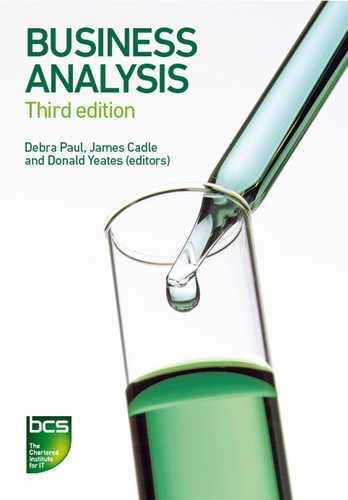PREFACE
This is an exciting time for business analysis. There are now practising business analysts working at all levels of seniority in most organisations and the role is recognised increasingly by professionals from other disciplines, both within the IT function and the business units. The sixth BA Conference Europe is scheduled, with increasing numbers attending year on year. There are numerous publications on business analysis, and social media abounds with (mostly relevant!) BA blogs, videos and debates. Many business analysts hold certifications; at the time of writing, BCS had issued over 75,000 certificates. Business analysis is taught in universities. Need we go on? It definitely feels like we have arrived!
This book was written originally to provide a breadth of information and guidance to practising business analysts at all levels – and that continues to be the case. As a result, it offers a wide-ranging source of practical guidance on how to approach business analysis and how to apply concepts and techniques. The book also supports anyone wanting to achieve professional certifications in business analysis especially those studying for the BCS International Diploma in Business Analysis.
We have included material drawn from research, discussions, and conversations with practitioners in business analysis in the UK, Europe, Australia, the USA and Canada. However, we have been struck by the number of people who are not within this group but have told us that they have found the book helpful. These include students across IS-related disciplines, and managers and staff from various organisational departments, including marketing and HR. Ultimately, it offers information for anyone wishing to improve their understanding of business analysis.
Some important changes in this edition include:
- an expanded discussion on the philosophy and use of Agile;
- a new chapter that looks at using gap analysis to identify potential improvements and the application of business architecture to ensure the alignment of proposed business changes;
- a new chapter looking at the role of the business analyst through the business change lifecycle;
- additional approaches and techniques in areas such as situation investigation and business process modelling.
The challenges facing organisations have increased since we wrote the first edition of this book. The advent of the economic crisis that affected many countries is still being felt. As a result, organisations need to spend money wisely and the need for good analysis to help ensure this has never been greater. In this third edition, we have once again extended the toolkit required of a good business analyst. But we make no apologies for this – such an important role will always need to develop and extend its reach.
Thanks must go to Alan Paul – husband of Debbie – for reviewing much of the book and improving it. Thanks also to Rachel Bellman for interpreting Debbie’s jottings and creating an excellent rich picture.
Matthew Flynn and his team at BCS have made it all come together in the end. Once again, their help and support was invaluable.
Debra Paul
James Cadle
Donald Yeates
